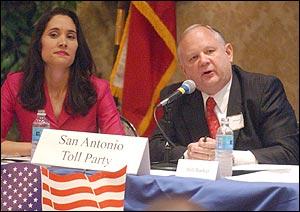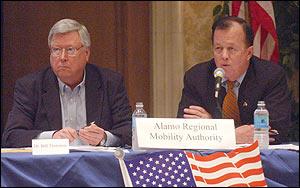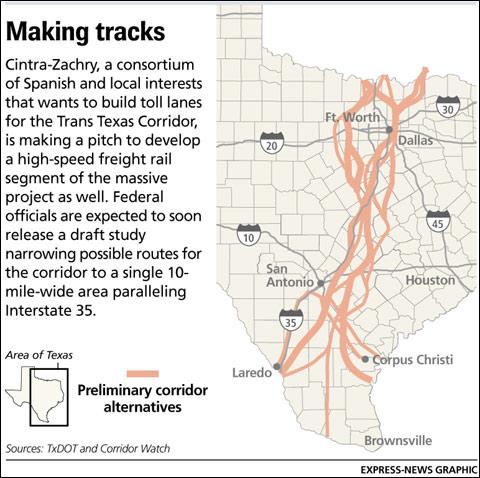NOTE: The Trans Texas Corridor will receive funds from the blank check Prop 1 corporate rail slush fund just like we said it would before the voters of Texas got duped into passing it!
Authorities eye high-speed cross border train from Dallas – Mexico
Robin Brundell
BNamericas.com
Business News Americas (Latin America’s Business Leader)
Friday, March 31, 2006
The Texas Transportation Commission (TTC), part of the US state’s Department of Transportation (TxDOT), has received a proposal from two construction firms to build a high-speed rail route from Dallas into Mexico, said deputy executive director of the TxDOT, Steve Simmons, confirming local news reports.
The railroad, nearly 1,000km long, would be part of the Trans Texas Corridor project, an ambitious plan to combine roads, rail transport, utilities and energy pipelines in a single corridor.
The plan, being worked on by the US construction firm Zachry and its Spanish partner Cintra, would use less land than traditional expansion methods, improving transport efficiency and taking hazardous cargo away from heavily populated areas.
Nearly half of Texas’ population lives within 50 miles (80km) of the I-35 interstate highway, which runs for a total 2,518km, passing through Texas from Duluth in Minnesota, eventually reaching Laredo on the Mexican border.
Because of the high levels of congestion on this highway, Texas authorities have been forced to act and that response has been the basis of the Trans Texas Corridor scheme, which in principle would run parallel to I-35 and would be called the TTC-35.
“We solicited proposals on that and selected [the consortium] Cintra-Zachry… and they teamed together and came up with a proposal,” Simmons told BNamericas.
The contract with the firms is to look the best ways of executing and financing the corridor, said the US official, adding: “We’re looking at this as a public-private venture.”
This corridor, which would cost an estimated total of US$5bn, would be developed over the next 50 years using a market-based toll system to make developments as and when they are needed.
“The Trans Texas Corridor is not just a toll highway as we look at it today. The long range is separate car and truck lanes, plus six rail lines, which would carry high-speed freight and commuter rail services, and a corridor for utilities,” the TxDOT official said.
This cross-border rail line could become attractive to companies moving cargo to and from Mexico, as well as those handling Asian goods arriving through Mexican ports. It may also stimulate the development of dry ports and multi-modal transport terminals along its route.
The rail line would be financed by Cintra and Zachry through quotas paid by rail companies, but it could also be eligible to receive funding from the Texas Rail Relocation and Improvement Fund.




